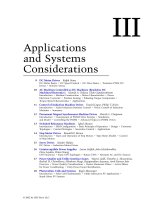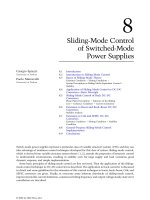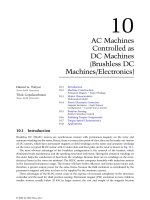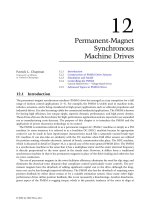Power Electronic Handbook P9
Bạn đang xem bản rút gọn của tài liệu. Xem và tải ngay bản đầy đủ của tài liệu tại đây (261.1 KB, 8 trang )
© 2002 by CRC Press LLC
III
Applications
and Systems
Considerations
9 DC Motor Drives
Ralph Staus
DC Motor Basics • DC Speed Control • DC Drive Basics • Transistor PWM DC
Drives • SCR DC Drives
10 AC Machines Controlled as DC Machines (Brushless DC
Machines/Electronics)
Hamid A. Toliyat, Tilak Gopalarathnam
Introduction • Machine Construction • Motor Characteristics • Power
Electronic Converter • Position Sensing • Pulsating Torque Components •
Torque-Speed Characteristics • Applications
11 Control of Induction Machine Drives
Daniel Logue, Philip T. Krein
Introduction • Scalar Induction Machine Control • Vector Control of Induction
Machines • Summary
12 Permanent Magnet Synchronous Machine Drives
Patrick L. Chapman
Introduction • Construction of PMSM Drive Systems • Simulation
and Model • Controlling the PMSM • Advanced Topics in PMSM Drives
13 Switched Reluctance Machines
Iqbal Husain
Introduction • SRM Configuration • Basic Principle of Operation • Design • Converter
Topologies • Control Strategies • Sensorless Control • Applications
14 Step Motor Drives
Ronald H. Brown
Introduction • Types and Operation of Step Motors • Step Motor Models • Control
of Step Motors
15 Servo Drives
Sándor Halász
DC Drives • Induction Motor Drives
16 Uninterruptible Power Supplies
Laura Steffek, John Hecklesmiller,
Dave Layden, Brian Young
UPS Functions • Static UPS Topologies • Rotary UPSs • Alternate AC and DC Sources
17 Power Quality and Utility Interface Issues
Wayne Galli, Timothy L. Skvarenina,
Badrul H. Chowdhury, Hirofumi Akagi, Rajapandian Ayyanar, Amit Kumar Jain
Overview • Power Quality Considerations • Passive Harmonic Filters • Active Filters
for Power Conditioning • Unity Power Factor Rectification
18 Photovoltaic Cells and Systems
Roger Messenger
Introduction • Solar Cell Fundamentals • Utility Interactive PV Applications •
Stand-Alone PV Systems
© 2002 by CRC Press LLC
19 Flexible, Reliable, and Intelligent Electrical Energy Delivery Systems
Alexander Domijan, Jr., Zhidong Song
Introduction • The Concept of FRIENDS • Development of FRIENDS • The Advanced
Power Electronic Technologies within QCCs • Significance of FRIENDS • Realization
of FRIENDS • Conclusions
20 Unified Power Flow Controllers
Ali Feliachi, Azra Hasanovic, Karl Schoder
Introduction • Power Flow on a Transmission Line • UPFC Description and Operation •
UPFC Modeling • Control Design • Case Study • Conclusion
21 More-Electric Vehicles
Ali Emadi, Mehrdad Ehsani
Aircraft • Terrestrial Vehicles
22 Principles of Magnetics
Roman Stemprok
Introduction • Nature of a Magnetic Field • Electromagnetism • Magnetic
Flux Density • Magnetic Circuits • Magnetic Field Intensity • Maxwell’s
Equations • Inductance • Practical Considerations
23 Computer Simulation of Power Electronics
Michael Giesselmann
Introduction • Code Qualification and Model Validation • Basic Concepts—Simulation
of a Buck Converter • Advanced Techniques—Simulation of a Full-Bridge (H-Bridge)
Converter • Conclusions
© 2002 by CRC Press LLC
9
DC Motor Drives
9.1 DC Motor Basics
9.2 DC Speed Control
9.3 DC Drive Basics
9.4 Transistor PWM DC Drives
9.5 SCR DC Drives
9.1 DC Motor Basics
The DC motor consists of two basic parts: a stationary magnetic field and a current-carrying coil on the
armature. The force produced by the interaction of these two components produces a torque that causes
the armature to rotate. The stationary magnetic field is produced by a permanent magnet for many small
DC motors. Large and extended speed range motors use an electromagnet to produce the stationary field
permitting the drive to control the field strength. The armature coils consists of a series of individual
coils connected to the DC power source through a commutator and brushes. As the armature rotates,
the commutator switches successive coils into the circuit to keep the armature coil and magnetic poles
in the same relative position.
The field flux
φ
(Eq. 9.1) is a function of the field current
I
f
and a proportionality constant
k
f
. The
torque
T
produced (Eq. 9.2) is related to the field flux and armature current
i
a
by the proportionality
constant
k
t
. The speed of a DC motor is controlled by the torque produced by the motor and the torque
required by the load. When the motor torque exceeds the load requirement, the rotational speed of the
motor increases.
(9.1)
(9.2)
The armature current is in response to the applied voltage
V
(Eq. 9.3) and is opposed by a counter-
voltage (
e
a
) produced by the armature coil rotating through the stationary magnetic field and the armature
resistance (
R
a
). The countervoltage (Eq. 9.4) produced by the armature is proportional to the strength
of the stationary field and the rotational speed (
S
). Below the rated base speed of the motor the current
in the stationary magnetic field coil is kept constant. Therefore, at values below base speed the DC motor
speed is a function of the applied voltage and resistive loss in the armature.
(9.3)
(9.4)
f k
f
I
f
=
Tk
t
fi
a
=
Ve
a
R
a
i
a
+=
e
a
k
e
φ
S=
Ralph Staus
Pennsylvania State University
© 2002 by CRC Press LLC
Some DC motors have an additional winding in series with the armature to increase field strength in
proportion to the armature current. With this series field, the voltage at the motor terminals is propor-
tional to the speed of the motor without the reduction due to armature resistance. The improved
performance permits open-loop speed control providing a reasonable steady-state response.
These equations for DC motor speed control are valid for steady-state analysis but do not account for
the inertia of the motor or the inductance of the armature winding. To provide for a quick response, the
DC drive must provide additional torque (current) to overcome the motor inertia and additional voltage
to overcome the armature inductance.
DC motors are often used at greater than the base speed of the motor. Base speed is the rotational
speed where the motor produces rated horsepower at rated torque. Below this speed, the motor may be
operated at rated torque without overloading. Above base speed, the motor torque must be limited to
prevent exceeding the horsepower limit.
9.2 DC Speed Control
The first applications of variable-speed control for large (10 to 1000 Hp) motors are known as the Ward
Leonard Motor-Generator (M-G) systems (Fig. 9.1). In these systems a large constant-speed AC motor
is mechanically coupled to a DC generator. The voltage produced by a DC generator is a function of
rotational speed and the strength of the magnetic field. Controlling the field current of the generator
with a rheostat can efficiently control the voltage produced by the generator operating at a constant
speed. A rheostat in the generator field circuit controlled the field current of a few amps while the DC
generator produced current in hundreds of amps at the controlled voltage. The speed of the connected
motor is a function of the voltage supplied by the generator and the field current of the motor. When
the same DC generator powers several DC motors, rheostats in each of the motor field circuits allow
individual motor speed control.
State-of-the-art steel industry bar mills through the 1950s used M-G systems. A typical mill installed
in 1952 used a 7500 hp synchronous AC motor coupled to three DC generators. One generator was
electrically connected to the reversing mill, the second connected to the two-high mill, and the third
connected to the bar mill so the voltage applied to each could be separately controlled. The reversing
mill and the two-high mill motors were operated with full field current to enable the use of the full
torque capability of the motors. To enable the use of small rheostats to control significant generator field
current that would be varied continuously, a small M-G was applied with the main generator field as its
load. The use of armature contactors for direction and field current rheostats for generator voltage control
provided the full range of required voltages.
The bar mill consisted of five motors each requiring individual speed control. The product (steel bar)
exit speed of each reduction stand must match the entering speed of the subsequent stand. The exit speed
of each stand is a function of the entering speed and the bar reduction. In the mill, the speed of the
product exiting a stand increased if the reduction rolls were moved closer together by the operator on
FIGURE 9.1
M-G system.
© 2002 by CRC Press LLC
the production floor. As the floor operator adjusted the roll gap to produce the proper size, the field
currents required adjustment. A second operator would monitor the size of the loop formed between
the stands and adjust the rheostats to compensate for the roll gap changes.
With the introduction of semiconductors, systems were installed to take advantage of the diode. In
the 1960s, large DC motors were replacing steam power turbines at many mills. Rather than installing a
M-G set, a diode bank and an associated transformer provided a constant DC power source. The DC
motor and gear reducers were selected to operate above base speed in the constant horsepower range.
The goal was to increase efficiency and reduce maintenance costs. In the M-G set, both the AC motor
and the DC generator were less then 100% efficient and each required maintenance of brushes and
bearings. The solid-state constant DC voltage source increased efficiency and reduced maintenance costs.
Speed regulation still used rheostats and the motor speed control was open loop. One significant disad-
vantage of the diode DC voltage source compared with the M-G source was the inability to regenerate
power. Motor speed could not be reduced rapidly without having a bank of resistors to dissipate the excess
energy. The M-G set would convert from a consumer of electric power to a supplier when the load speed
was faster than the desired.
Transistor developments in the 1960s and 1970s brought further gains to large DC motor control.
With the introduction of transistorized field current regulators, the motor speed was controlled electron-
ically with a rapid closed-loop response. A small DC generator, referred to as a tachometer, provided a
voltage proportional to the motor speed. The transistor field current regulator compared the tachometer
feedback to the speed set point and adjusted the field current to control the motor speed.
The use of rheostats and early transistor regulators were inefficient for speed control when applied in
the armature circuit. With the development of new systems using pulse width modulated (PWM) voltage
regulators, the armature voltage for small motors could be controlled. Systems up to several horsepower
were successfully applied to DC motors using permanent magnet fields. The power dissipated by the
transistor when gated-on is minimal and the power while gated-off is zero. However, the power the transistor
is required to dissipate while turning on and off limited the size of these systems. The application of PWM
transistors as field current regulators to large DC motors of hundreds of horsepower provided the efficiency
and closed-loop response of transistorized control to large systems.
The introduction of thyristor or silicon-controlled rectifiers (SCRs) provided for the revolution in
control of large DC motors. SCRs were applied in both the field current regulators and the armature
voltage regulators. With the SCR came increased efficiency, the ability to regenerate power, and high
power capability. DC drives and motors from a few horsepower to hundreds of horsepower could be
operated and controlled efficiently in all four quadrants when powered by three-phase line voltage. In
addition, systems were developed for DC-to-DC control for the operation of battery-powered equipment.
The latest development in the DC motor control is the introduction of the insulated gate bipolar
transistor (IGBT) to large power systems. These transistors have a fast switching time that reduces the
power the transistor is required to dissipate. With the introduction of the IGBT came a movement to apply
the concepts and lessons learned to large AC systems. Predictions were made that DC systems were obsolete
and would soon be replaced. However, DC systems have proved to be dependable and cost-effective. They
are still being applied when the application is suitable for economic reasons.
9.3 DC Drive Basics
Speed regulation in analogue drives is accomplished with a proportional–integral–derivative (PID) reg-
ulator for the voltage output. The input to the equation was the speed error and the output is used to
drive the voltage regulator. A faster response is obtained by using the output of the PID equation as the
input to the current regulator. A second PID regulator uses the output of the current regulator as an
input to control the voltage. When additional speed is required, additional current is called for. The
current regulator call for more voltage force increased current. The increased current provides additional
torque resulting in increased speed.









